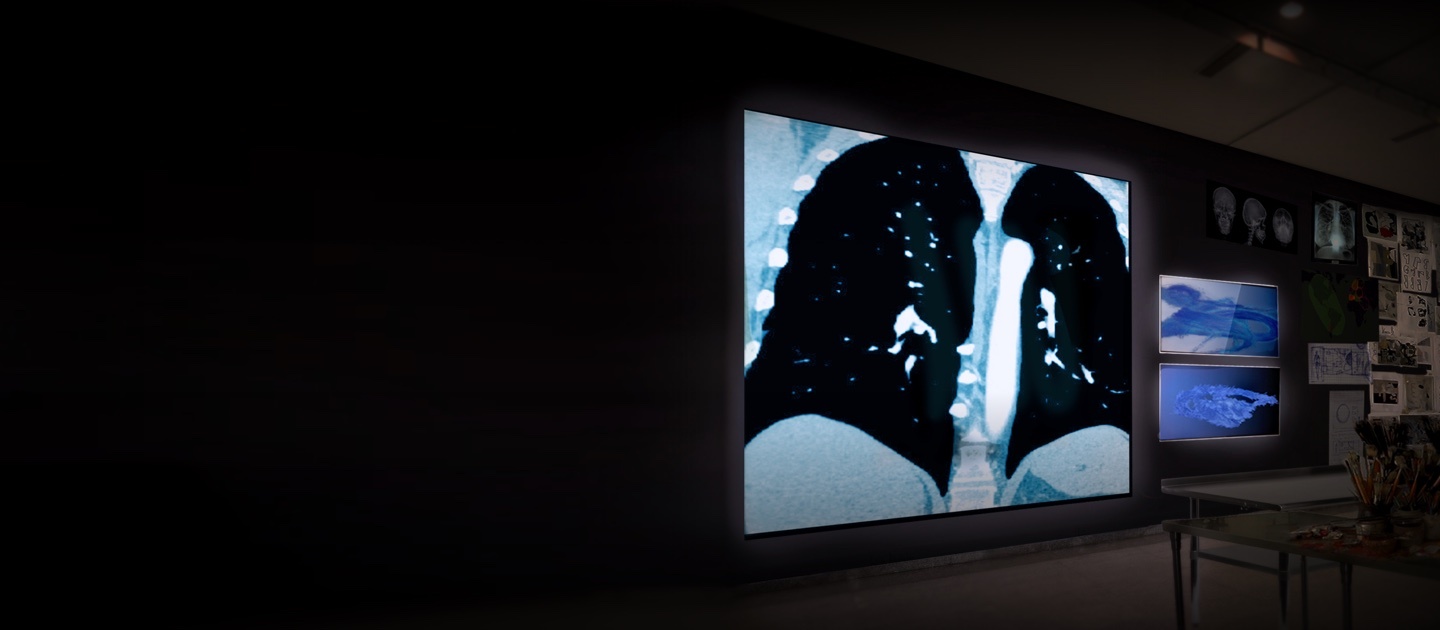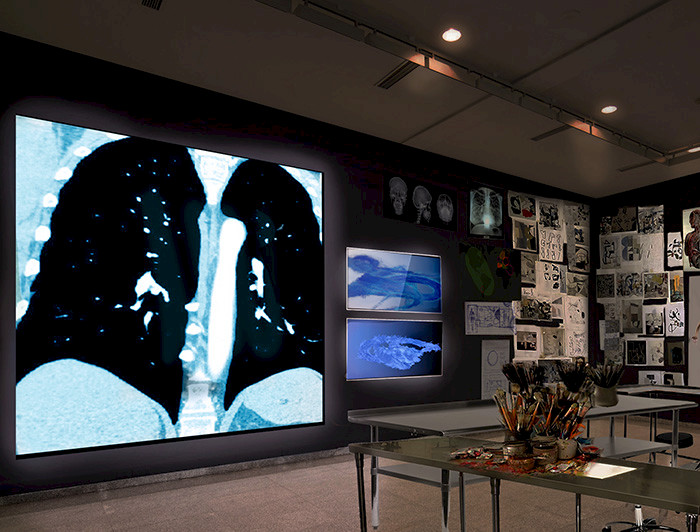
How to look at the world from other perspectives
The "notion of the body" and "landscapes of memory" are the concepts that give rise to the reflection on two projects that merge science and art. They are making it clear that more than merely bringing together professors from different areas is about crossing disciplinary boundaries and generating new knowledge.

photo_camera "Blood Cartographies. Atlas and Diagram" and "Geography, Art and Climate Change: Landscapes of Memory in the Explorers Valley, Chilean Patagonia" are two of the ArTeCiH Competition projects that are currently underway. (Photo: Installation in Sala Gasco/Gastón Laval)
Research in art and science can take unexpected turns and arrive at surprising results, which takes us out of our comfort zone and forces us to reflect and look at the world from other perspectives. For example, it can change the concepts we have in our minds, in this case, of such trivial elements as maps, cartography, and territory.
That change is what these two projects -supported by the Arts & Technology, Science and Humanities (ArTeCiH) Competition and promoted by the Office of Arts & Culture of the Office of the Vice President for Research- did.
This initiative, in the words of its director and winner of the 2020 National Prize for the Musical Arts, Miryam Singer, "promotes dialogue for learning about other methodologies, other interesting objects that populate the world, that is difficult to recognize when looked at from a separate, isolated perspective." (Read the article "Art and Science: A Firm Commitment to Interdisciplinarity")
Discipline on the Edge
Creating a work that reflects on the body's concept is the objective of "Cartografías de la Sangre. Atlas y diagram" [Blood Cartographies. Atlas and Diagram], an interdisciplinary project that links art, science, medicine, and medical technology, through artistic research.
This project aims to discuss how different disciplines have approached the body's representation, using medical images as a starting point to trigger a process of reflection and joint creation. This process is far from simple.
On the one hand, the body is an ever-changing concept, depending on the historical, social, and cultural context.
On the other hand, medical images are data able to be turned into paintings or sounds.
They group a team to address this challenge, including:
- Gastón Laval, visual artist and a faculty member from the School of Art.
- Sergio Uribe, professor of the Faculty of Medicine and the Institute of Biological and Medical Engineering, as well as director of the Center for Biomedical Imaging and the Millennium Nucleus of Cardiovascular Magnetic Resonance
- Milena Grass, a professor from the School of Theater and director of the Millennium Nucleus in Art, Performativity, and Activism.
- Rodrigo Cádiz, a professor from the Institute of Music and the Faculty of Engineering.
Students from the Faculties of Arts, Medicine, and Engineering were also part of the group.
The team has held several sessions to present points of view, many times divergent and even opposing. "It seems to me that it is essential in a group of professors to be able to discuss and see how we understand things, where we are going, what we intend to do and what we don't. These competitions are an excellent opportunity to do that," said Rodrigo Cádiz, who is both an engineer and a musician. "What we have tried to do is to make the result a hybrid thought, more than bringing together people from different disciplines," he said.
"I agree that it is possible to integrate art, science, and technology, but it has been a process of getting to know each part of the language, nomenclature, and disciplinary language, to reach a certain agreement," added the artist Gastón Laval.
The methodology was then to have conversations and make presentations to explain what each one understood by art and science and what aspects of the other's discipline interested them. After, the idea of approaching the project from the concept of "turbulent flow" was born, which comes from fluid mechanics.
"Turbulence operates at the level of the human body: the bloodstream is turbulent, and at the micro-level, the exchange of nutrients is also turbulent; and so is the flow of rivers, the sea, the air or people circulating in the streets... From the micro to the macro: in the human body, the social body, and the celestial body, there is a physical law present," said Gaston Laval.
According to Cristián Pinet, the project coordinator, "It has been fascinating to see the entire creative process, how the terms of each discipline are crossed, and how knowledge begins to be generated."
The next step is to decide how to give an account of this reflection in an exhibition -which will be held in Gasco Showroom- that involves science, technology, and art, as much as visual, sound-musical, and performative aspects. It will be divided into two parts:
- A traditional exhibition
- A kind of laboratory-workshop with interactive elements for the public.
The experience will include not only images but also the sonification of medical data. The idea is to "take advantage of the sense of hearing as another input, as we are quite visual. There are many ways to transform data into sound, evoking other things different from the image," said Rodrigo Cadiz
The exhibition, still in development, is expected to be shown in March or April 2021.
According to Gastón Laval, the value of this initiative is "to push one's own experience to the limit to immerse oneself in that of the other, to understand it and from there to carry out truly collaborative work."
Landscapes of Memory
!["[In this project,] we consider the concept of landscape of memory, which is a way of understanding the landscape from another point of view. It sees the landscape not as something inert, which is out there, but in a direct relationship with the human being, with the experience of the people who inhabit it, with the lived space, with their memory", explained professor Andrés Núñez. (Photo: Exploradores Valley/Nicole Saffie)](/site/efs/files/13059/exploradores.jpg)
Reveal the impact of climate change on one of the most pristine places in the extreme south of our country is the objective of the project "Geografía, Arte y Cambio Climático: Paisajes de la Memoria en el Valle Exploradores, Patagonia Chilena" [Geography, Art and Climate Change: Landscapes of Memory in the Explorers Valley, Chilean Patagonia].
This project is conducted by professors Andrés Núñez of the Institute of Geography, and Roberto Farriol, from the School of Art. The idea was born as a joint initiative. Each faculty in their discipline had already been working with the landscape and territory for some time.
Through a video-essay (which includes a reflection), they will try to identify and represent the impact of climate change in this place, home of the UC Patagonia Interdisciplinary Research Station, which is associated with this project. However, it is not a mere geographical verification, for example, of how glaciers have receded, but instead delves into deeper domains: its inhabitants' memory.
"[In this project,] we consider the concept of "landscape of memory," which is a way of understanding the landscape from another point of view. It sees the landscape not as something inert, which is out there, but in a direct relationship with the human being, with the experience of the people who inhabit it, with the lived space, with their memory", said Andrés Núñez. "The landscape of memory looks at the past and seeks to investigate the traces that changes have left."
Although fieldwork has been delayed due to the COVID-19 pandemic, the professors have continued to work based on historical photographs. They wanted to understand what the landscape was like and how it looked, and what elements stood out in those images.
Other elements are the accounts of inhabitants and historical videos, such as Augusto Grosse, an explorer. He went into the valley looking for possible routes to connect with the sea in the mid-20th century.
The video-essay has several axes. As explained by Roberto Farriol: "The first one has to do with the documentation, pictures, and videos of the location, that place us in a moment. Then, the interviews that will be carried out in the place, that account for another memory: The stories are constructions, which change over time".
The images will enable us to compare how a place used to be and how it is now. But it goes beyond that. Through the stories, there is a clash between those images and the memory. All of which will be contrasted with scientific data, for example, regarding the climate or the soil. In this way, "Science becomes part of a story, and art becomes a platform for that story," said Farrell.
"An interesting aspect of the video is the changes in time, which shows the simultaneity of episodes and moments. Some of them are real, and others fictional, depending on what has been built on reality. It is a kind of metaphor of what it means to be in the place, and to understand that the landscape is not only physical but that we build it", explained the art professor.
During the video exhibit, the viewers could immerse themself in the work and experience it. In the artist's own words, what they are trying to achieve is "to move people, stop seeing what we are used to, to ask ourselves questions."
These memory landscapes are understood from the geography expressed through art in various interpretation levels, constituting a story called "climate change." The video-essay is thought (written) to examine a natural phenomenon on a cultural fabric.
"The question we ask ourselves in this whole paradisiacal scenario is how the people who live there see it. There is an image created by visitors or people who have just arrived in the region. Returning to the pristine, it is a new memory, different from the one of its inhabitants. The landscape is not out there, but inside each person, it is the product of a cultural trajectory," concluded the geography professor.


